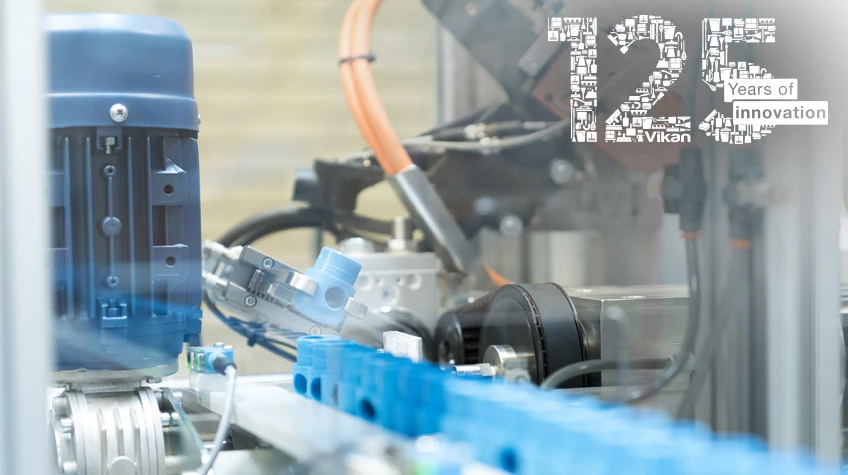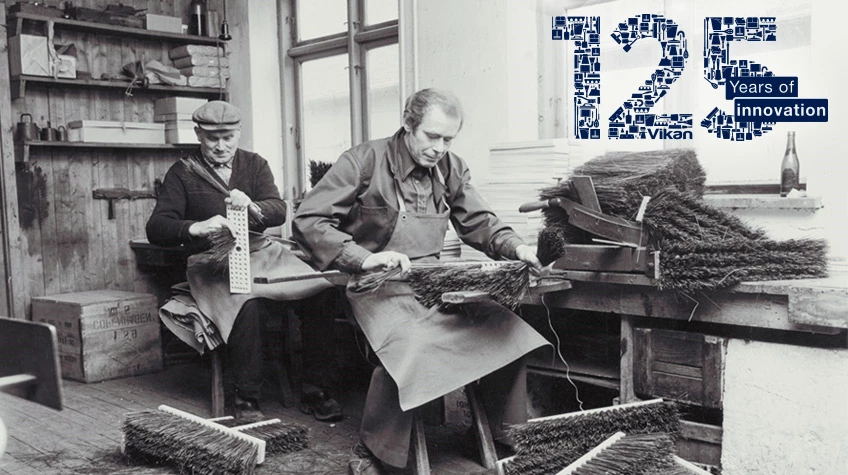This blog post is part of a brief series celebrating Vikan’s 125th anniversary. We’ve dug into the archives to uncover stories that highlight key themes and milestones in our journey so far. In doing so, we hope to offer a glimpse into who we are today as a company. What's in a brush? It's a question we take very seriously — literally. In fact, you can trace the entire 125-year history of our company by looking at the materials used in our products. Before diving into this, let's consider why these materials matter so much. Brushes and cleaning tools don't just need to clean; they must also be clean themselves. A dirty tool won’t do the job properly. The choice of materials and the design of the tool directly affect both its cleaning performance and how easily it can be kept clean. In the 19th century, when Vikan was founded, brushes were made with wooden handles and bristles made from natural fibers, held together with twine. At that time, before industrialized food production, the focus was on effectiveness and durability. The founder, A.P. Pedersen, carefully selected materials based on their function. His shop stocked various natural fibers for different types of brushes, such as scrub brushes, street sweepers, and dairy brushes. Records show he used at least four types of piassava fiber, along with horse and boar hair, some sourced from India and China for finer brushes. By the 1930s, Vikan had a dedicated mixing room where different fibers were combined for specialized uses. During World War II, limited access to foreign materials pushed the company to innovate and find alternatives, showcasing an early sign of Vikan’s inventive spirit. Despite these changes, the core goal remained: to create durable and effective cleaning tools. Since the mid-1960s, Vikan had been producing plastic brushes, but things changed dramatically in the early 1970s after a study found higher bacteria levels in refrigerated areas of a Danish meatpacking plant after cleaning. This discovery, along with growing awareness of hygiene, marked a new era for Vikan. Cleaning tools now needed to not only clean effectively but also remain hygienic themselves. Vikan responded by rethinking the materials used in its products. The conclusion was clear: synthetic materials like plastic and nylon were the future. This led to the creation of the groundbreaking “White Series†of hygienic brushes for the food and beverage industry. Today, Vikan is recognized globally as a leader in hygienic cleaning tools — tools that are both effective and easy to keep clean. An interesting point is that sometimes it's what we stop using that makes a difference. For example, removing staples and resin and using fully molded bristles in the UST range helped eliminate two potential food contaminants. Today, cleaning tools that come into contact with food must meet strict material requirements, including food-contact compliance. Vikan leads the industry in this area, using only compliant materials and providing detailed Declarations of Compliance online for every product. From wood and natural fibers to modern plastics and nylon, the materials Vikan has used over the years have played a crucial role in its leadership in hygienic cleaning solutions for the food and beverage sector. In his memoir, Life and Works, Vikan founder A.P. Pedersen recounts a number of experiences from the company’s earliest days and reflects upon them as an older man looking back on his life. Some of these moments reveal the foundation of Vikan’s innovative spirit. There is no doubt that Vikan’s 125 years of growth – and the company’s current position as global market leader – are closely linked to technology. Ever wondered what the Vikan name means, and where it comes from? Here’s the answer. Delicate and light loose powder,Waterproof setting loose powder,Refreshing toner loose powder,Non-clogging pores Loose powder,As fine as the fog Loose powder Guangzhou Boxuanya Cosmetics Co.Ltd. , https://www.cosmeticsbxy.comThe importance of materials in Vikan’s history

Recent blog posts

The origins of Vikan’s approach to innovation

Vikan, technology, and people

Vikan - the story behind the name
See all posts
Lotte Jensen - Marketing Project Manager
Lotte Jensen - Marketing Project Manager
Lotte Jensen - Marketing Project Manager